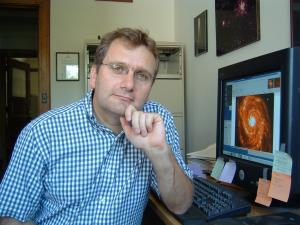Year born: 1960
Research Areas: Observational Astronomy, Supernovae, Cosmic Distances
"I would love to be able to see with my naked eye, the next galactic supernova. The last one occurred in 1604. On average, a galaxy like ours should produce one supernova every 50 years,"
Source: Interview with Bruce Dorminey

Early Life
Mario was born in Chile. Although his dad was a politician Mario found a love for science. He got degrees in physics and astronomy from the University of Chile.
Career Highlights
In 1987, he started work researching at a telescope site. A few days into his job, a new light appeared in the night sky. It was a supernova, a star that had exploded very close to the Milky Way. It was in one of our small nearby galaxies, the Large Magellanic Cloud. This supernova, SN1987a, was the brightest one seen from Earth for 400 years. Mario started to observe it and soon became an expert on these objects.
He then started a project with 3 of his colleagues. It would change what we know about the Universe. They led the Calán/Tololo Supernova Survey. It set out to study the explosions of stars and use them to measure distances in space. In the first 4 years, they found 50 of these rare events.
The survey led to a big surprise. A type of supernova, called type Ia, were thought to explode at the same exact brightness. We call these types of objects standard candles. They can be used for measuring distances in space. By seeing how bright they look to us on Earth, we can work out how far away they must be. Mario's survey found that they were not perfect after all. The team worked out a way to still be able to use them to make accurate measurements of distances in space. The method involved watching the supernovae for many weeks after the explosion. The way the supernova changed in this time could be used to correct the data.
This change was small but crucial. Up to then, scientists knew the Universe was getting bigger, but they could not measure how fast it was growing. They didn't even know if the expansion was steady, slowing down, or speeding up. How it changed could show us how it might end.
Mario's survey let scientists make accurate measurements of this expansion. They used the Hubble constant. This measures the expansion and how it changes over time. The further away a star explodes, the further back in time we see. So all of Mario's work meant that the Hubble constant could be worked out over a long time. It showed that the Universe was getting bigger, but that the speed it was growing was getting faster. This in turn led to the idea of Dark Energy. A force that cannot be seen but that is pushing space apart. We now think that 70% of the Universe is made of this Dark Energy.
In 2011, the Nobel Prize for Physics was given for the discovery: the growing expansion of the Universe, measured using distant star explosions. Mario's team did not get the prize, but they were given credit for the work that made the discovery possible.
In the early 2000s Mario went to the USA where he got his Ph.D. from the University of Arizona followed by the prestigious Hubble and Carnegie postdoctoral fellowships. Mario missed home and so returned to Chile to become a Professor at the University of Chile. He directed the Chilean national observatory for 8 years. He has written many research papers and has been referenced more than any other Chilean astronomer.
For 2 years, Mario was the scientific advisor to the President of Chile. In 2018, he helped to create Chile's Ministry for Science and Technology.
In 2019 Mario became the Vice President for the AURA group and the director of their observing sites in Chile. AURA manages some of the biggest telescopes in the world. He left this post in 2021 and now heads the Chilean Astronomy Foundation. This is a non-profit foundation that promotes, protects and preserves the skies of Chile for astronomy.
Legacy
The Asteroid 109097 Hamuy was named after Mario. In 2015, he won Chile’s National Prize for Exact Sciences. In 2016, he won the World Academy of Sciences Prize.
Other Interests
Mario has written 4 popular science books in Spanish. In his spare time, he enjoys playing tennis. He is a big fan of watching films.
